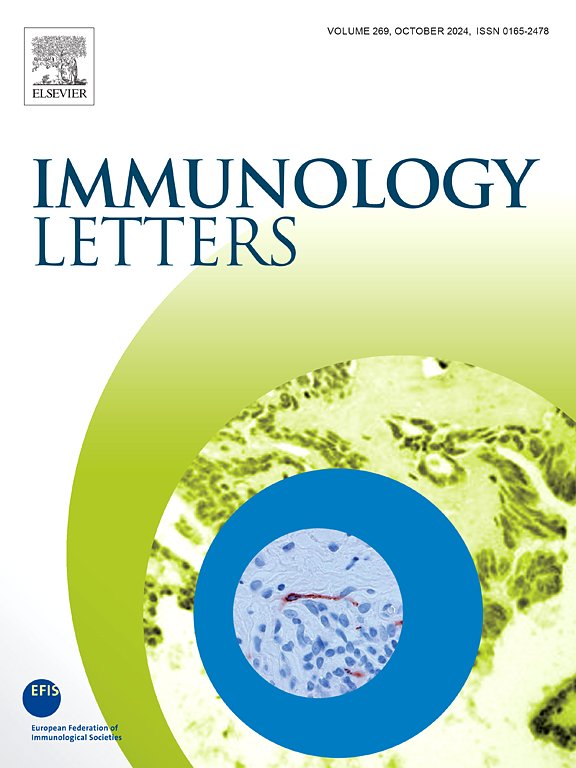成人继发性HLH淋巴细胞TCR免疫库特征及特异性差异基因分析
IF 2.8
4区 医学
Q3 IMMUNOLOGY
引用次数: 0
摘要
噬血细胞性淋巴组织细胞增多症(HLH)是一种严重的、危及生命的、以过度免疫激活和全身免疫失调为特征的高炎症性疾病。尽管在诊断方面取得了进展,但对HLH免疫库的潜在改变仍然知之甚少。本研究旨在表征HLH患者T细胞受体(TCR)免疫库的重塑,重点关注V(D)J基因使用、互补决定区3 (CDR3)多样性和克隆型分布,以更好地了解该疾病的免疫学基础。方法30例患者,其中未经治疗的HLH患者16例(U组),诱导后治疗的HLH患者4例(T组),健康对照10例(Hc组)。外周血TCRβ测序分析V(D)J基因使用、CDR3长度分布和库多样性。应用相对多样性指数(RDI)和V-J配对频率的分层聚类来评估免疫库的变化。统计分析采用单因素方差分析和Wilcoxon秩和检验来评估组间差异,显著性阈值为P <;0.05.结果与健康个体相比,HLH患者的TCR多样性发生了显著变化,包括CDR3长度变异性增加和V(D)J基因使用的变化(P <;0.05)。特别是在HLH患者中观察到TRBV5-1和TRBJ2-7的表达。V-J配对分析表明,HLH样本与健康对照明显聚集,提示免疫失调。RDI分析显示,M-HLH组的多样性显著高于非M-HLH组(P <;0.05),表明恶性亚群的克隆扩增程度较高。诱导治疗后,TCR多样性部分恢复(P <;然而,免疫库与健康个体仍然不同(P <;0.05)。结论shlh与免疫库重构密切相关,特别是在V-J基因配对和CDR3多样性方面。RDI值和基因配对的显著差异提示抗原驱动的HLH患者克隆扩增。免疫库谱分析可以作为HLH分类和疾病监测的有效生物标志物。进一步的研究需要更大的队列和纵向数据来验证这些发现,并探索其在HLH中的临床应用。本文章由计算机程序翻译,如有差异,请以英文原文为准。
Characteristics and specific differential gene analysis of the TCR immune repertoire in secondary adult HLH lymphocytes
Background
Hemophagocytic lymphohistiocytosis (HLH) is a severe, life-threatening, and hyperinflammatory disorder characterized by excessive immune activation and systemic immune dysregulation. Despite advancements in diagnosis, the underlying alterations in the immune repertoire in HLH remain poorly understood. This study aimed to characterize remodeling in the T cell receptor (TCR) immune repertoire in patients with HLH, focusing on V(D)J gene usage, complementarity-determining region 3 (CDR3) diversity, and clonotypic distribution, to better understand the immunological basis of the disease.
Methods
Thirty individuals were enrolled, including 16 untreated patients with HLH(U group), 4 patients with HLH undergoing post-induction therapy (T group), and 10 healthy controls (Hc group). Peripheral blood TCRβ sequencing was performed to analyze V(D)J gene usage, CDR3 length distribution, and repertoire diversity. The relative diversity index (RDI) and hierarchical clustering of V-J pairing frequencies were applied to evaluate immune repertoire alterations. Statistical analyses included one-way ANOVA and Wilcoxon rank-sum tests to assess group differences, with a significance threshold of P < 0.05.
Results
Compared to healthy individuals, patients with HLH exhibited significant alterations in TCR diversity, including increased CDR3 length variability and shifts in V(D)J gene usage (P < 0.05). In particular, TRBV5–1 and TRBJ2–7 expression was observed in patients with HLH. The V-J pairing analysis demonstrated that HLH samples clustered distinctly from healthy controls, suggesting immune dysregulation. RDI analysis revealed a significantly higher diversity in the M-HLH group than in the non-M-HLH group (P < 0.05), indicating higher clonal expansion in the malignant subgroup. Following induction therapy, TCR diversity showed partial recovery (P < 0.05);however, the immune repertoire remained distinct from that of healthy individuals (P < 0.05).
Conclusions
HLH is associated with profound immune repertoire remodeling, particularly in V-J gene pairing and CDR3 diversity. The RDI values and significant differences in gene pairing suggest antigen-driven clonal expansion in patients with HLH. Immune repertoire profiling may act as an effective biomarker for HLH classification and disease monitoring. Further studies with larger cohorts and longitudinal data are required to validate these findings and explore their clinical application in HLH.
求助全文
通过发布文献求助,成功后即可免费获取论文全文。
去求助
来源期刊

Immunology letters
医学-免疫学
CiteScore
7.60
自引率
0.00%
发文量
86
审稿时长
44 days
期刊介绍:
Immunology Letters provides a vehicle for the speedy publication of experimental papers, (mini)Reviews and Letters to the Editor addressing all aspects of molecular and cellular immunology. The essential criteria for publication will be clarity, experimental soundness and novelty. Results contradictory to current accepted thinking or ideas divergent from actual dogmas will be considered for publication provided that they are based on solid experimental findings.
Preference will be given to papers of immediate importance to other investigators, either by their experimental data, new ideas or new methodology. Scientific correspondence to the Editor-in-Chief related to the published papers may also be accepted provided that they are short and scientifically relevant to the papers mentioned, in order to provide a continuing forum for discussion.
 求助内容:
求助内容: 应助结果提醒方式:
应助结果提醒方式:


